Museums And Art Collection
Art collection is the systematic accumulation of works of art by private individuals and public institutions such as museum. Historically a close connection exists between private and public collection. Sir Kenneth Clark, British art historian, notes: “When all is said, the world owes private collectors an enormous debt. Without them, many of the greatest works of art would have been lost or destroyed. Our public collections are, to a far larger extent than anyone realises, private collections which have been accumulated and combined.”
History notes that art collecting began with the earliest civilisations; the Chinese, Indian, Sumerian, Egyptian, Cretan, Babylonian and Persian.
These early collections were priceless for their aesthetic value than for their religious significance and for their intrinsic worth. The early collection formed as it were a king of national treasury, a reserve of public wealth and a symbol of the nation’s credit.
When the treasury outgrew the vault or strong room, it was taken into the sanctuary and the temple. This gave rise to the establishment off the first Museum in Alexandria by the Greeks in 290 B.C.
It is seen, therefore, that the Greeks were the first to collect art on a large scale; the Romans followed them. Then subsequently other nations followed and for our purposes, came the British who exhibited the arts and crafts of colonial subjects in the British Museum.
The first crusade in Museum was for things to be seen easily by man, the second determined how things are to be seen, displayed and exhibited while the third was to establish why things are to be seen, the idea behind the exhibit and the excuse for attracting attention.
In the light of the current thinking in the world today the word Museum has been defined by the International Council on Museums (ICOM) as: “A non-profit, permanent institution in the service of society and its development, open to the public, which acquires, conserves, researches, communicates and exhibits tangible and intangible heritage of humanity and its environment for the purpose of education, study and enjoyment.”
Museum And Private Investor In Art
The National Commission for Museums and Monuments is a creation of statute Decree 77 of 1979. Although its functions are spelt out in that decree and Decree No. 9 of 1974, its statutory mission is further amplified in the Cultural Policy for Nigeria, published in 1988.
Its principal objective set out by law, therefore, includes, collection, preservation, presentation, and administration of art objects of unique and antique nature.
Over the years, it has established itself within the ambit of government not only as a repository but also as a depository of works of arts spanning over 2000 years. It has also trained experts in this field from within as well as outside Nigeria. It has an intellectual base as well as a scientific approach to its objectives. As part of its functions, it has assisted and will continue to assist state governments, communities and private individuals in establishing museums, art galleries, and in certifying and identifying arts objects of unique or antique importance as well as collecting and preserving them. Its doors are open to members of the public for these and other varied services.
Herein lies the relationship between the Museum as a government institution and the private individual who collects works of art as an investment.
It is also in this regard that this topical issue is of immense interest to us as an institution which is the sole national agency under the law responsibilities for not only the mission stated in this paper but also for the control of their movement, ownership as well as building the necessary international contact in theses areas.
The topic has become emergent in what is believably a justified approach to harnessing our varied efforts towards collecting, preserving and the administration of Nigeria’s cultural heritage.
Culture in this sense; “consists of patterns, explicit and implicit, of and for behaviour required and transmitted by symbols constituting the distinctive achievement of human groups, including their embodiments in artifacts: the essential core of culture consists of traditions (i.e. historically decided and selected) ideas and especially their attached values; culture system may, on the one hand, be considered as products of action, on the other as conditioning element of further action.”
It is common knowledge that in cultural policy for Nigeria, the government did not prohibit private invest in the arts. Although government established the National Commission for Museums and Monuments as its agent to collect through purchase and preserve its artistic and cultural heritage, yet it is true that this Commission cannot even pay for the art object sized let alone involve itself in direct purchases.
It is in this direction that rich individuals can be called upon to perform their patriotic duties by purchasing this object as an investment. This way they will be saving for themselves as well as the country huge sums of money that will be needed eventually in the future to repurchase this art objects from Europe and American art market. We all know that if this is done, illegal smuggling of art objects out of Nigeria will be greatly discouraged and possibly eliminated.
The National Commission for Museum and Monument on its part will provide expert advice on the object not only as their authenticity but give expert advise on their preservation and exhibition. It is important to note that such investors in art, be they private individuals and corporations could be granted tax holiday deductible from their profit upon their favourable advice to government by this Commission.
The private investors could tap the expert knowledge available in the Museum as well as reap profitable from their investment. Even if such profit is not immediate, we have stated earlier that art appreciate, thus there is no way such an investor could lose. His person is elevated in the eyes of the government and the community accords him recognition in various ways.
Such investor will be on the mailing list of this Commission to attend important state functions.
Part of the reason for this presentation is to educate the financial agencies and the public at large on the profitability of investment in art. The National Commission for Museums and Monuments is willing to educate through this Commission in this hard times.
Finally, this Commission urges interested investors to visit art galleries generally but also to pay particular attention to the numerous exhibitions of the artwork of various Nigerian and international artists going on in the Museum from time to time.
At such exhibitions, it will be possible to purchase original authenticated works of art, which will grace their homes, increase the collections and as well serve as future security, if the authenticity by this institution as genuine with regard to originality and cost, such artworks can in fact be used as collateral for borrowing.
Source: The Guardian











